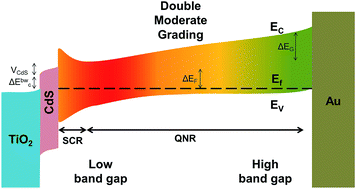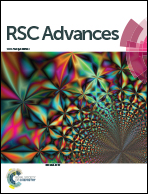All solution processable graded CIGS solar cells fabricated using electrophoretic deposition
Abstract
Graded band gap chalcopyrite solar cells are fabricated based on an all solution processable synthesis method with the aid of electrophoretic deposition and a superstrate structure. The solvothermally synthesized nanoparticles crystallize in the chalcopyrite–wurtzite mixed phase without any trace of impurity phases, as confirmed by XRD and Raman spectroscopy. Crack-free electrophoretic deposited films are formed. However, the porosity of the films is raised due to the Ga content. The J–V characteristics of the CuIn1−xGaxS2 samples are compared with those of back extreme grading (BEG), back moderate grading (BMG), and double moderate grading (DMG) solar cells. The highest efficiency (JSC = 16.50 mA cm−2, VOC = 640 mV, fill factor = 0.61, η = 6.44%) is achieved in DMG cells, mainly due to reducing the minority carrier recombination at the absorber/back contact interface by back grading and increasing the photoresponse or open circuit voltage by front grading in the space charge region. The medium double grading in this structure avoids notch formation in the band structure. Dark diode analysis demonstrates that the lowest series resistance, shunt conductance and reverse saturation current are obtained, as well as a diode ideality factor near 2, in DMG solar cells.


 Please wait while we load your content...
Please wait while we load your content...